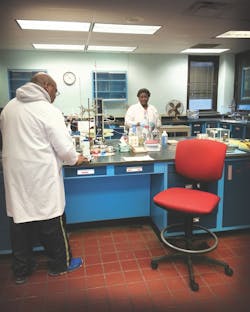About the author: Jeffrey Raymond is division chief, communications and community affairs, for the Baltimore City Department of Public Works. Raymond can be reached at [email protected] or 410.545.6541.
In Baltimore, compliance with state and federal water and wastewater regulations is not simply a matter of meeting the minimum requirements. The city has worked under one of the first sanitary sewer overflow consent decrees in the nation, striving since 2002 to bring its wastewater system into compliance with rigid state and federal guidelines. But under the leadership of Rudolph S. Chow, P.E., director of the Baltimore City Department of Public Works (DPW), compliance means doing the right thing.
In 2014, his first year as director, Chow created an Office of Compliance and Laboratories; the chief of that office, Kimberly Grove, P.E., reports directly to him. Her office includes two laboratory divisions that have been separated from the operations of the water and wastewater facilities; a plans review and inspections division that holds public and private contractors to regulatory standards related to water pollution; a field monitoring division that tracks and eliminates pollution sources within the city’s waters; and a partnership and planning division focused on collaboration to support an effective implementation of the various environmental initiatives within the city.
In order to further heighten the role of compliance, an employee committee is studying the creation of a permit compliance audit program. Such an auditor would report to Grove and be the point of contact for all of the agency’s permits—sewer, water, storm water, solid waste removal and disposal, and even energy. “There’s no reason we can’t do our own audits and fix any problems before the regulators do,” said Dana Cooper, the agency’s general counsel. A recommendation on how to staff the permit compliance position could come in the spring of 2015.
All Hands on Deck
In Baltimore, compliance means more than simply keeping regulators satisfied. Grove sees the agency-wide embrace of compliance as a new chapter for efficiency and transparency. Whereas previously compliance had been just one of the concerns facing each division of each bureau in the agency, it is now a comprehensive priority that gets its own executive-level chief. An integrated planning framework—using economic and social factors as well as regulatory considerations—is helping the Department of Public Works make long-term capital decisions. Grove said the agency is using technology such as mapping tools and modeling, as well as data generated by its new Office of Asset Management to fine-tune its decision-making process.
The city’s new approach means talking with and listening to people in the communities served by the DPW, Grove said. Meeting clean water standards, for example, should not necessarily mean spending resources the city does not have or disrupting neighborhoods. Nor will it mean downplaying important regulatory standards and goals. Grove is convinced the city can get where it needs to be by making members of the community—residential, business and environmental watchdogs—feel informed and even part of the decision-making process. “That social side of it is in there, as are resources,” she said.
Grove and Cooper played key roles in putting together the Baltimore City DPW’s new storm water utility. After being elevated to chief of the Office of Compliance and Laboratories, Grove oversaw the creation of a storm water advisory committee comprising interested civilians with backgrounds in environmental advocacy, engineering, business and community organizing. The group will review storm water operations and priorities, and recommend policy positions to Chow. It could be that the advisory committee model will be adopted in other functions of Baltimore’s DPW. With new state rules regulating trash in the city’s beloved Inner Harbor, Grove said trash disposal might be the next to get an advisory committee.
A Proactive Approach
From the outset of Chow’s term as director, he has sought to make the DPW more responsive to the public. Even as the agency works to meet the terms of its consent decree, for example, it is being proactive in how it deals with its aging water treatment and distribution system. The city is in the midst of an aggressive, expensive program of converting its open-air drinking water reservoirs into massive buried tanks. Compliance with the federal Safe Drinking Water Act did not necessarily require the tanks, but Chow determined that it was better to take on additional upfront costs to build the tanks and reduce the potential for harmful chlorine byproducts in the system, improve the city’s ability to maintain the system and anticipate future regulatory advances. For example, its 4,000 miles of water main are coming in for major long-term reinvestment.
Another example of this proactive philosophy will be evident later this year when the city begins construction of a massive project to increase the capacity of its Back River Wastewater Treatment Plant. This project is not part of its consent decree compliance, Cooper said, but it is expected to enhance the effectiveness of the consent decree projects and dramatically reduce sewer overflow elsewhere in the system.
Baltimore is known for strong neighborhood councils and non-governmental organizations. They have no regulatory power, but they can confront the city through the courts. Chow has met with key environmental leaders and has served as co-chair of the Waterfront Partnership, which brings business and nonprofit leaders together with government officials to clean up the city.
The groups bring technical expertise and commitment to the same environmental and public health concerns that the DPW is trying to address. “We view them as a resource,” Cooper said.
While not everyone always agrees on timelines and specific priorities, Chow’s embrace of overall goals has enhanced the DPW’s credibility among environmental and community groups.
Download: Here
